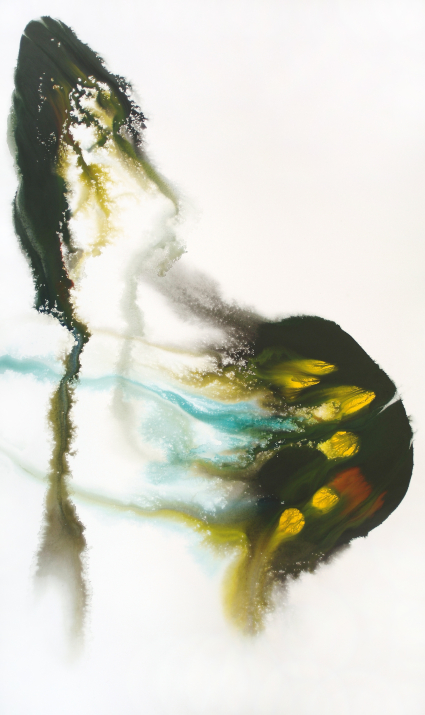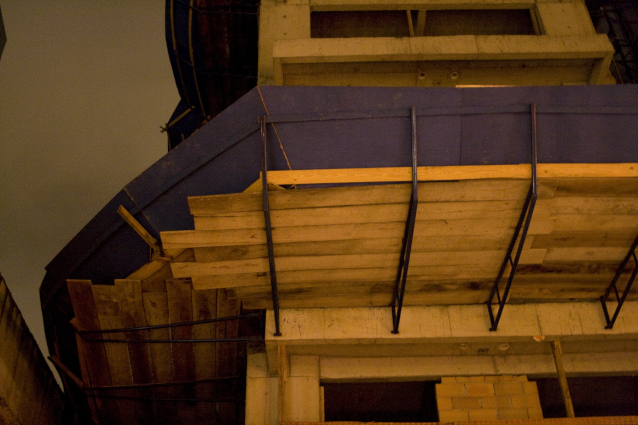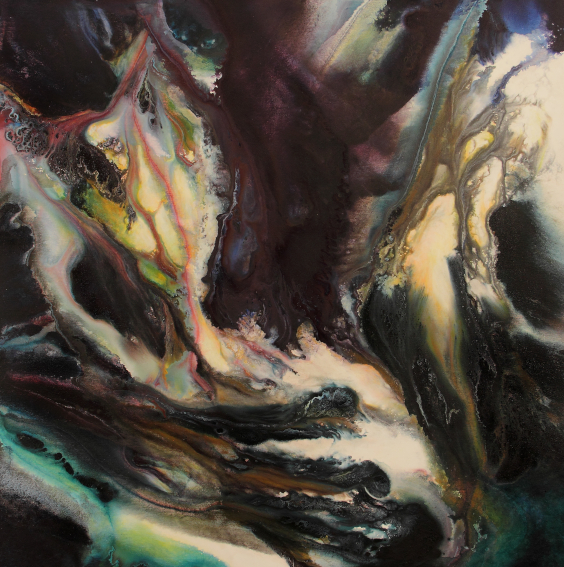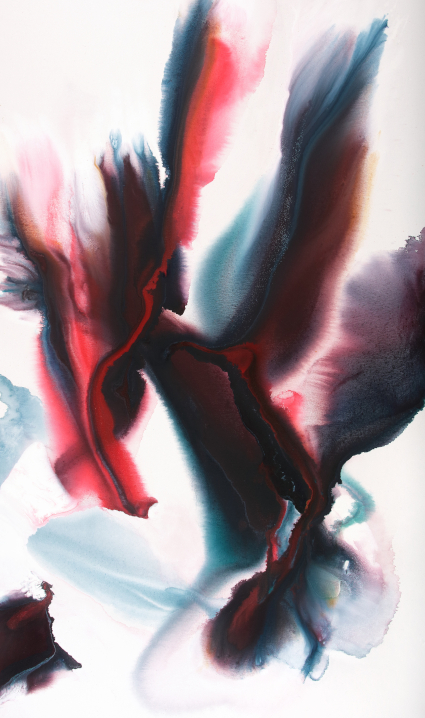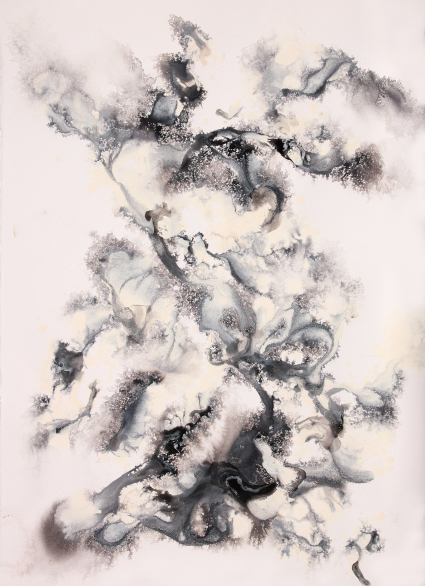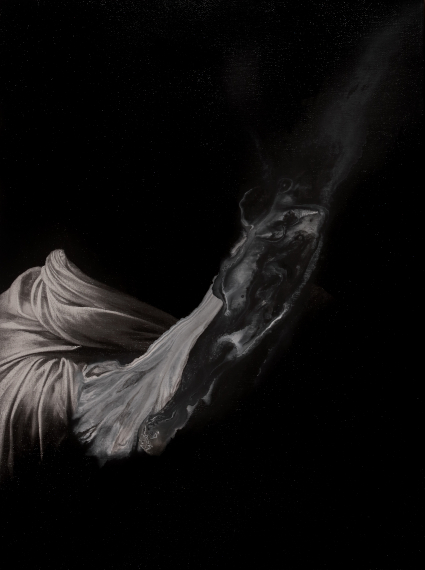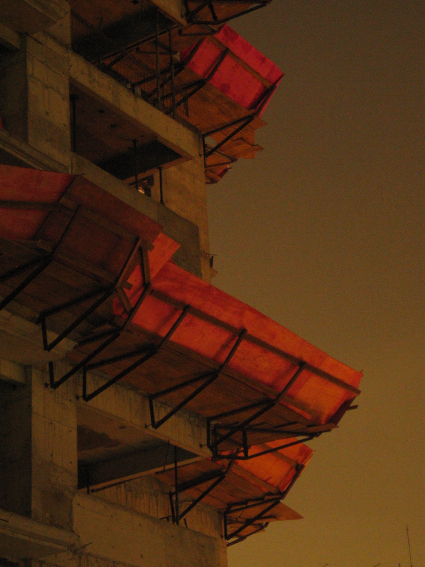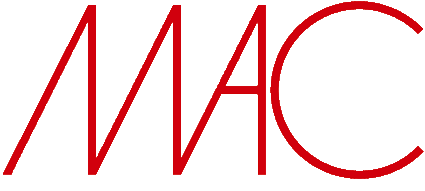Cartografias de mundos inexistentes - Manoel Veiga
Heloisa Espada - MAC USP
Num primeiro momento, as pinturas de Manoel Veiga (Recife, 1966) se parecem com a vista aérea de uma paisagem de fluídos coloridos, que ora esbarram em sedimentos, ora se penetram e se confundem. Rios sem margens – ou de limites difusos – em que a forma é consequência de seus próprios percursos.
A aparência de vista aérea se justifica, entre outras coisas, pelo fato de o artista trabalhar com a tela deitada no chão. Não há marcas de gestos porque ele não usa (ou usa muito pouco) o pincel. O principal instrumento é um borrifador de água, daqueles de molhar roupas ou plantas, que direciona a tinta de forma indireta. O trabalho começa com a seleção de pigmentos não somente a partir de critérios cromáticos, mas de acordo com a forma, o peso e o tamanho. Uma vez que a mistura de tinta acrílica é aplicada sobre a tela, Veiga borrifa mais ou menos água na superfície das obras, levando em conta que as cores de pigmentos maiores e mais pesados vão afundar mais rápido do que os leves, que tendem a acompanhar o movimento da água. Suas pinturas registram um processo de negociação com fenômenos que estão por toda parte: gravidade, difusão e capilaridade. Ao invés de representar a natureza, o artista trabalha com ela para imaginar novas configurações de espaço e tempo.
O vínculo com a ciência tem origem na formação de Manoel Veiga em Engenharia Eletrônica e na experiência como pesquisador em laboratórios de física. Após se dedicar a fundo ao estudo das técnicas de nomes icônicos da história da pintura, tais como, Hans Holbein (c. 1497-1543), Caravaggio (1571-1610) e Jean-Auguste Dominique Ingres (1780-1867), por volta de 2000, a pintura se tornou um lugar de experimentação e de reflexão sobre a dinâmica dos fluídos. Sua arte é uma espécie de laboratório onde é possível manipular leis da natureza que regem o cotidiano e a relação das pessoas com o tempo, escolhas pessoais e aquilo que acontece à revelia dos desejos, como o envelhecimento dos corpos e a movimentação de matérias diversas no espaço. Como ele mesmo costuma dizer, “o caos total e o controle total são duas utopias. Estamos sempre no meio dessas duas coisas”. Em suas obras, Veiga trabalha com probabilidades estéticas a partir de conceitos da física e da química.
De 1994 a 1999, nos primeiros anos da transição da Engenharia para a arte, o artista se dedicou sobretudo a técnicas tradicionais como uma forma de conhecer e dominar materiais da pintura. No entanto, o interesse pela ciência, pela fotografia e pela arte de seu próprio tempo fez com que seu trabalho logo se tornasse um campo de experimentação tanto estética como conceitual. Não sem ironia, em 1997, Veiga realizou um retrato de Marcel Duchamp (1887-1968), outro mito da história da arte, misturando técnicas usadas por Rubens (1577-1640), Caravaggio, Cézanne e Holbein (ver a assinatura em trompe l’oeil). A escolha do inventor do ready made como modelo indicava que, na trajetória de Veiga, a destreza técnica não seria um objetivo em si, mas uma etapa de um percurso crítico sobre os modos da arte existir e comunicar.
Sem seguir uma ordem cronológica, esta exposição apresenta pinturas e fotografias realizadas principalmente nos últimos 15 anos. Além de várias etapas de suas pesquisas sobre dinâmica dos fluídos, há exemplos da série Construções, realizada a partir daquilo que apenas a câmera digital é capaz de ver; da série Hubble, feita com a manipulação de imagens do famoso telescópio da Nasa; Matéria escura, em que a obra de Caravaggio é estopim para uma nova investigação sobre o espaço; e a recente série Espectros, na qual o artista funde fotografia e pintura.
As obras de Manoel Veiga dão a ver fenômenos científicos onipresentes, que agem quase sempre no cotidiano de forma sutil e silenciosa. Ainda assim, mundos inexistentes são imaginados a partir de certos anseios. Sua poesia vem da busca de um equilíbrio (certamente fugaz) entre o desejo de mudança pela ação individual e o fluxo dos acontecimentos sempre fora do controle.
Cartographies of nonexistent worlds. Manoel Veiga
Heloisa Espada - MAC USP
At first glance, the paintings by Manoel Veiga (Recife, Brazil, 1966) look like aerial views of a landscape made up of colorful fluids that either run into sediments or else penetrate each other and amalgamate. One sees borderless rivers, or streams of diffuse limits, where form is corollary to their pathways.
The appearance of aerial views can be justified – among other things – by the fact that the artist works with the canvas laid out on the floor. No traces of hand movement will be found, because he very seldom applies brush strokes to his paintings. His main tool is a water atomizer – the type we commonly use to sprinkle plants or to spray clothes when ironing, – that will indirectly guide the paint along its support. The artistic work starts with the selection of pigments based not only on a chromatic criterion, but in accordance with form, weight and size. Once the acrylic paint mixture is applied on canvas, Veiga sprays more or less water on the surface of the work, taking into account that larger and heavier color pigments are bound to sink faster than the light ones which will follow the movement of the water. His paintings display a negotiation process with phenomena of our daily lives: gravity, diffusion and capillarity. Instead of representing nature, the artist works along with it in order to imagine new configurations of space and time.
The art/science interconnection originates in Manoel Veiga’s education as an electronic engineer, as well as in his experience as a researcher in physics labs. After studying in minute detail the techniques of iconic names in the history of painting, such as Hans Holbein (c.1497-1543), Caravaggio (1571-1610), and Jean-Auguste Dominique Ingres (1780-1867), it was approximately in the year 2000 that painting established itself in Veiga’s life as an environment for experimentation and reflection on fluid dynamics. His art is a sort of lab where it is possible to manipulate laws of nature that rule both our daily lives and the relation we have with time, personal choices, and everything that happens in spite of our desires – for instance, the ageing of our bodies and the ways in which different matters move in space. As Veiga himself insists, “Total chaos and total control are utopias. We will always find ourselves between these two.” In his paintings, the artist works with aesthetical probabilities brought about by concepts from physics and chemistry.
From 1994 to 1999, in the first years of his transition from engineering to art, Veiga focused on traditional techniques as a way of studying and mastering different painting materials. Subsequently, his interest in science, photography and contemporary art led him to gear his work towards this experimental field of his that is both aesthetical and conceptual. It was not without irony that Veiga, in 1997, painted a portrait of Marcel Duchamp (1887-1968), yet another mythical figure in art history, by mixing techniques employed by Rubens (1577-1640), Caravaggio, Cézanne (1839-1906), and Holbein (see his signature in trompe l’oeil). Choosing the creator of readymade art as his model denotes that, in Manoel Veiga’s career, technical dexterity was not his goal, but rather a stage in his serious course of thinking about ways in which art can both exist and communicate.
The present exhibition, though not chronologically organized, presents paintings and photographs for the most part created over the last fifteen years. It encompasses not only the several stages of the artist’s research work on fluid dynamics, but here we have examples as well of the series Construções (Constructions), created from photographing sights only the digital camera could capture; of the series Hubble, created from manipulating images of the well-known NASA’s telescope; of the series Matéria escura (Dark Matter),created from paintings by Caravaggio that sparked in Veiga a new investigation on matters of space; and the more recent series Espectros (Specters), created from a fusion of photography and painting.
Manoel Veiga’s artwork brings before our very eyes omnipresent scientific phenomena that will almost always operate in our everyday life in subtle, silent ways. Nevertheless, given certain yearnings and aspirations, nonexistent worlds can be imagined. Their poetry comes from one’s search for a state of (always evanescent) balance between a wish for change due to individual action and the flow of events that is out there, always out of control.
Galeria
